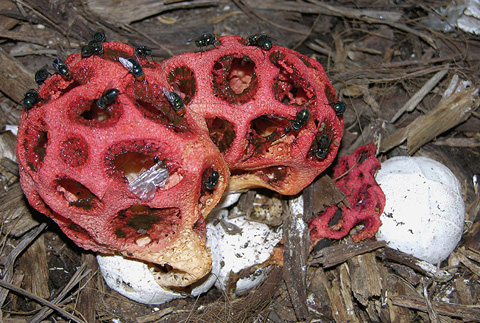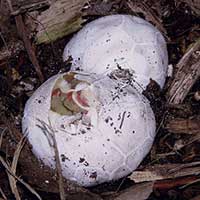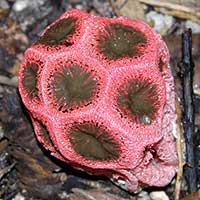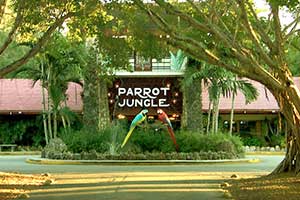
The Lattice Stinkhorn, It’s Slimy and It’s Smelly

Now that you are mulching your garden regularly with chipped tree trimmings from your favorite tree service, you feel good at the fact that all of that mulch is being kept out of the landfill and being put to good use by recycling it into nutrients for your plants. The micro-flora and fauna that live around the plant roots are happy and thriving while imparting nutrients to the plants and keeping the pressure on plant pathogenic organisms.
So one morning you take a walk outside to enjoy the cooler temperature and humic scent given off by all of those hard working bacteria that are helping to decompose that organic material. You then happen upon this bright red sponge-like thing lying in the mulch that looks like it just came in from outer space. Suddenly you are not only marveling at this garish glob but notice an odor that smells like the bottom of an old wet garbage can. Oh, and what’s with all the flies zipping around?
Assuming that you are in South Florida, the Caribbean or northern South America, you have just come upon a specimen of Clathrus crispus, one of the tropical stinkhorn mushrooms. This distinctive group of mushrooms is famous for popping up in gardens (and flower pots) overnight and attracting every fly in the neighborhood. The attraction to the flies is of course the odor which is one of the distinctive characteristics of this group of mushrooms. At some point in its very brief life of a day, a foul-smelling nasty slime is generated that attracts the flies. As the flies dine on the slime, they inadvertently pick up minute stinkhorn spores on their tiny feet or even eat them. Eventually the flies leave this fine meal of slime and the spores get dispersed to propagate more stinkhorns. This method of reproduction/distribution is different from most mushrooms which have their spores dispersed as a dry powder by the wind. Remember spores for fungi and ferns serve the same function as seeds for other more advanced groups of plants.
Two unique characteristics of the stinkhorns separate them from other fungi: the slime and the fruiting structure (the colorful part with the slime and spores) that arises from what appears to be an “egg”. You will notice these white egg-like structures partially buried in the mulch for a couple of days. Then one morning the “egg” bursts open and a stinkhorn emerges in all of its fetid glory. Many species of fungi are quite edible and I understand that some folks eat these “eggs” but I couldn’t imagine eating something so nasty and foul smelling no matter how well-fried.
California and Mexico are home to a species of stinkhorn, Clathrus ruber that is also red and looks similar to ours. And in Cuba and Jamaica, a yellow stinkhorn known as Clathrus baumii can be found.
But whether you’ve found a stinkhorn or another species, the mushrooms we see above ground are a very short-lived part of the normal growth of a fungus. Its only purpose is to serve as a reproductive structure. The actual fungus is living quite happily below ground where it is busily decomposing woody and other organic materials. The main body of the fungus is composed of thread-like structures called mycelium which can be often seen by raking off a thin layer of mulch that will expose these fungal strands.
Many species of fungi form symbiotic relationships, known as mycorrhiza, with plants and trees. Attaching themselves to the roots, the fungi provide the plants with water and certain nutrients, and receive in turn plant-manufactured nutrients. There is much scientific evidence that this fungal – plant relationship greatly benefits the plants, suppressing root pathogens that would otherwise attack and harm the plants.
Unlike the stinkhorns, many species of fungi have their reproductive organs below ground. The truffles that we eat are actually underground fruiting bodies that attract animals that dig them up to eat. This of course is another method to disperse spores. The group of fungi that includes the edible truffles are also well known for their symbiotic mycorrhizal relationships with trees.
Jeff Shimonski
October 2007






 About Compost, Mulch & Tilth
About Compost, Mulch & Tilth The Lattice Stinkhorn, It’s Slimy and It’s Smelly
The Lattice Stinkhorn, It’s Slimy and It’s Smelly Relocating A Theme Park With A Compost Foundation
Relocating A Theme Park With A Compost Foundation How the use of Compost and Mulch has been an Important Component of a Successful Integrated Pest Management Program
How the use of Compost and Mulch has been an Important Component of a Successful Integrated Pest Management Program Composting at Parrot Jungle and Gardens
Composting at Parrot Jungle and Gardens